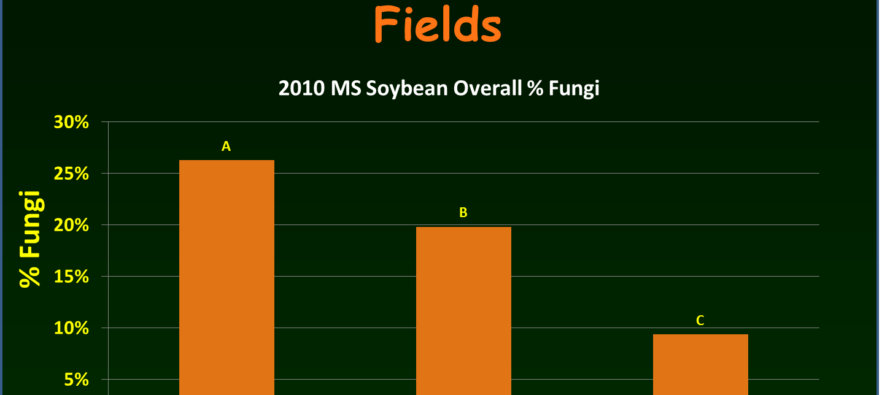Managing Late Season Stink Bugs in Mississippi Soybean

Over the last month we have had numerous questions about terminating stink bug applications in late season soybeans. Typically we manage stink bugs until near harvest but there are several things to consider before making an application to control stink bugs in beans beyond R6 growth stage.
1. Once all pods are R6, actually yield loss from stink bugs is very low to none.
2. After R6 stink bug issues are restricted to quality loss and possibly creating avenues for disease to set in if harvest is delayed.
3. Soybeans can tolerate many more stink bugs than “normal threshold” past R6 before quality deductions are measured.
4. Preharvest intervals for insecticides becomes a consideration.
Stink bugs cause yield loss typically by feeding on developing seed throughout the R5 growth stage. If seed are not fully developed in the pod, seed fed on by stink bugs are often aborted or shriveled up. Seed fed on at R6 stage and beyond typically do not shrivel or lose size but have a feeding legion on the seed. When elevators grade soybean seed, stink bug damage is only counted 1/4 percent compared to heat, mold or other grading factors. So stink bug damage carries 75% “less weight” than other forms of damage. This may be why we don’t always receive deductions even when we had high populations in the field.
1. SB damage to developing seed. 2. Stink bug damage to seed that is filled out. Click to Enlarge
In MS we recommend you at least double the threshold at R7 but the data shows on average it takes much higher numbers than 2X threshold to actually cause quality deducts. I would encourage growers to strongly consider a desiccant rather than an insecticide if you have made it to R7 and save the money.
Stink bugs, weather, and disease probability:
Logically we have always assumed that a field of stink bug damaged pods may lead to greater incidence of disease and/or general seed rot if conditions were favorable for development and beans had to stay in the field for any prolonged period of time. Recently we had a student that studied the incidence of fungi associated with soybeans as influenced by stink bug damage. The figure below shows fungal incidence from random soybeans that were collected from producer fields in the Delta region in 2010. Soybean were shelled by hand and separated into three categories; stink bug damaged seed, seed that was damaged from other factors not including stink bugs, and seed that had no visible damage. Seed were then plated on a general microbiological growth medium and monitored for fungal development. Seed that were categorized as having stink bug damage did in fact have a significantly greater likelihood of fungi developing on the culture plates. It is not uncommon for tropical storms to develop this time of year and rain to set in on beans in the field and delay harvest beyond physiological maturity. While diseases such as Phomopsis seed decay can certainly be an issue in the absence of stink bugs, the likelihood of seed decay organisms leading to a loss of soybean seed quality may be greater if stink bugs are allowed to persist creating avenues (e.g., from wounding) for fungi to enter the seed.
Click to enlarge
Below is a decision aid we put together that addresses many of the questions we get everyday about late season stink bug applications. This will not fit every situation but can be used as a guideline for late season stink bug decisions.
Stink Bug Decision Aid For Late Stage Soybeans. Click To Enlarge

Redbanded Stink Bug is a more aggressive feeder:
In 2009 Redbanded stink bugs were treated in numerous areas of the state but numbers crashed in 2010 and this is the first year they have been an issue since then. The crash in 2010 was likely due to cold winters in 10 and 11 and it has taken them until now to get established again. In a recent trip to south MS I observed very high numbers in a field. Redbanded stinkbug are more aggressive feeders than our normal stink bug complex and re-infest fields much quicker after treatments. Because of this, the threshold is was reduced from 9/25 sweeps to 6/25 sweeps for this species. In fact, this year LA has even reduced their threshold further to 4/25 sweeps for Redbanded stink bugs.
Here are the results of some Redbanded Stink Bug trials from 2009 on insecticide performance. Click on any to enlarge.













Let me tell You a sad story ! There are no comments yet, but You can be first one to comment this article.
Write a comment